Browsing the Future: How 3D Laser Scanning Services Are Changing Industries
Industrial maintenance using laser scanning .Intro
In the realm of technical advancement, couple of technologies have actually been as transformative as 3D laser scanning services. These advanced tools have transformed industries by using exceptional precision, performance, and adaptability. From design to archaeology, from producing to medication, the applications of 3D laser scanning are huge and consistently increasing. In this article, we delve into the ins and outs of this technology and explore how it is improving the landscape of numerous industries.
Recognizing 3D Laser Scanning
At its core, 3D laser scanning is a non-contact, non-destructive innovation that records the shape, dimension, and information of items or environments by emitting laser beam of lights. These beam of lights bounce off the surfaces they come across, and the scanner determines the time it considers each beam of light to return, therefore producing a point cloud—-- a collection of countless information factors that represent the things'' s geometry in 3 dimensions.
The Benefits of 3D Laser Scanning
One of the main benefits of 3D laser scanning is its unequaled accuracy. Conventional methods of dimension usually fall brief in recording complicated geometries or complex information, leading to errors and ineffectiveness. With 3D laser scanning, however, also one of the most complex surfaces can be recorded with precision down to the millimeter, guaranteeing that every information is represented.
Furthermore, 3D laser scanning is unbelievably effective. Unlike standard surveying methods that can be taxing and labor-intensive, laser scanning permits rapid information purchase. A solitary scan can catch numerous information points in a matter of mins, significantly reducing the moment and sources needed for information collection.
An additional significant advantage of 3D laser scanning is its non-destructive nature. Unlike physical dimensions or invasive inspection methods, laser scanning does not require straight contact with the things being scanned, maintaining its stability and decreasing the risk of damages.
Applications Across Industries
The convenience of 3D laser scanning has brought about its prevalent adoption across a myriad of markets. In design and building, as an example, laser scanning is made use of for as-built paperwork, clash discovery, and constructing information modeling (BIM). By precisely catching existing conditions, designers and engineers can enhance the style process, lessen mistakes, and minimize expensive rework.
In the production sector, 3D laser scanning plays a critical function in quality control, reverse design, and quick prototyping. By specifically catching the dimensions of elements and products, producers can identify issues, maximize production procedures, and bring products to market much faster.
The influence of 3D laser scanning expands past the realm of market and into areas such as archaeology, forensics, and healthcare. Excavators use laser scanning to develop thorough 3D versions of historical sites and artifacts, permitting digital preservation and evaluation. In forensics, laser scanning is utilized to document criminal offense scenes, gather evidence, and reconstruct crashes with unparalleled accuracy. In healthcare, 3D laser scanning allows custom-made prosthetics, orthotics, and implants customized to the special composition of each patient.
Future Fads and Developments
As modern technology continues to breakthrough, the future of 3D laser scanning holds tremendous pledge. One arising fad is the combination of artificial intelligence (AI) and artificial intelligence formulas into scanning software, making it possible for automated feature acknowledgment, data evaluation, and modeling. This assimilation not just improves the speed and precision of scanning procedures yet additionally opens new opportunities for data-driven understandings and decision-making.
In addition, advancements in equipment, such as the advancement of handheld and mobile scanning tools, are making 3D laser scanning extra obtainable and portable than ever before. These small and lightweight scanners equip users to capture data in remote or challenging atmospheres, even more expanding the reach of this transformative innovation.
Conclusion
Finally, 3D laser scanning services are transforming sectors around the world, offering unrivaled precision, efficiency, and adaptability. From style to archaeology, from manufacturing to medication, the applications of 3D laser scanning are unlimited. As technology remains to advance, the future holds even better assurance, with technologies such as AI assimilation and portable scanning tools positioned to more expand the capacities of this transformative technology. In navigating the future, 3D laser scanning will most certainly continue to be at the center of innovation, reshaping sectors and driving development in the years to come.
